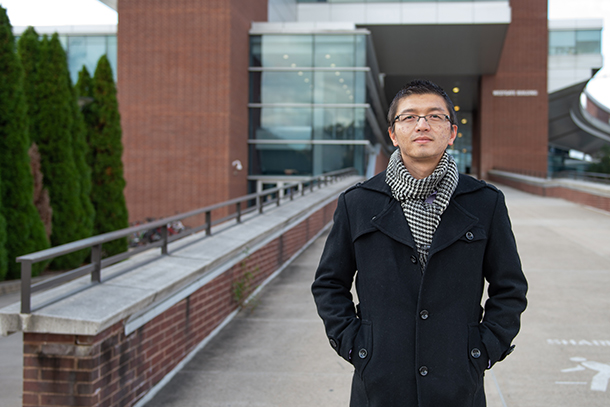
Huanyu “Larry” Cheng, James L. Henderson, Jr. Memorial Associate Professor of Engineering Science and Mechanics in Penn State's College of Engineering. Credit: Kelby Hochreither/Penn State. All Rights Reserved.
New soil sensor may improve efficiency of crop fertilization
March 24, 2023
By Mary Fetzer
UNIVERSITY PARK, Pa. — Measuring temperature and nitrogen levels in soil is important for agriculture systems but detecting them apart from one another is difficult to do. Huanyu “Larry” Cheng, James L. Henderson, Jr. Memorial Associate Professor of Engineering Science and Mechanics, led researchers in the development of a multi-parameter sensor that can effectively decouple temperature and nitrogen signals so that each can be measured accurately. The results were recently published by Advanced Materials.
“For efficient fertilization, there is a need for continuous and real-time monitoring of soil conditions, specifically nitrogen utilization and soil temperature,” Cheng said. “This is essential for evaluating crop health, reducing environmental pollution and promoting sustainable and precision agriculture.”
Using nitrogen as a fertilizer is common practice in agriculture, and the goal is to use the ideal amount for the best crop output. When too little is nitrogen is used, the crop’s yield may be less than optimum. When too much is used, fertilizer is wasted, plants can burn and harmful nitrogen gases are released into the environment. Accurate detection of nitrogen levels — specifically, the loss of nitrogen in the form of a gas — can help farmers achieve optimal levels of fertilization for plant growth.
“Plant growth is also impacted by temperature, which influences the physical, chemical and microbiological processes in soil,” said co-author Li Yang, professor in the School of Artificial Intelligence at China’s Hebei University of Technology. “Continuous monitoring enables farmers to develop strategies and interventions when temperatures are too hot or too cold for their crops.”
Unfortunately, both gases and temperature — along with relative humidity variations — can cause changes in the resistance reading of the sensor, so the sensor cannot tell them apart. Sensing mechanisms that can obtain nitrogen gas and temperature measurements independent of each other are rarely reported, according to Cheng.
Cheng’s team designed and fabricated a high-performance sensor to completely decouple the detection of nitrogen loss and soil temperature. The multi-parameter sensor is based on vanadium oxide-doped, laser-induced graphene foam. Vanadium oxide can adsorb and interact with nitrogen gases, and doping metal complexes in graphene have also been found to improve gas adsorption and detection sensitivity.
The sensor is encapsulated by a soft membrane that blocks nitrogen gas permeation so the sensor responds only to temperature variations. Additionally, the encapsulation can be removed and the sensor operated at an elevated temperature. Doing so removes the influence of relative humidity and temperature in the soil to allow for accurate measurement of the nitrogen gas. The combination of the encapsulated sensor and the unencapsulated sensor can completely decouple temperature and nitrogen gas without interference.
Decoupling temperature variations and nitrogen gas emissions can be leveraged to design and apply multimodal devices with decoupled sensing mechanisms for precision agriculture in all weather conditions, according to Cheng.
“The capability to simultaneously detect ultra-low nitrogen oxide concentrations and small temperature changes paves the way for the development of future multimodal electronic devices with decoupled sensing mechanisms for precision agriculture, health monitoring and other applications,” Cheng said.
Cheng’s work was supported in part by the National Institutes of Health, the National Science Foundation and Penn State. The National Natural Science Foundation of China, the Key Research and Development Project of Hebei Province and the China Postdoctoral Science Foundation also provided support.
Co-authors include Ankan Dutta, doctoral student of biomedical engineering at Penn State; Li Yang, Xue Chen, Shuaijie Du, Shiji Guo, Chuizhou Meng, Guangyu Niu, Ya Wang, Ye Xue and Jaiya Yan, all affiliated with Hebei University of Technology, China; Cheng Zhang, Minjiang University, China; and Peng Zhou, Tiajin Tianzhong Yimai Technology Development Co. Ltd., China.
Cheng is also affiliated with Penn State’s Institutes of Energy and the Environment; the Materials Research Institute; the Institute for Computational and Data Sciences; the Engineering, Energy, and Environmental Institute; the Sustainability Institute; and additional centers at Penn State.



